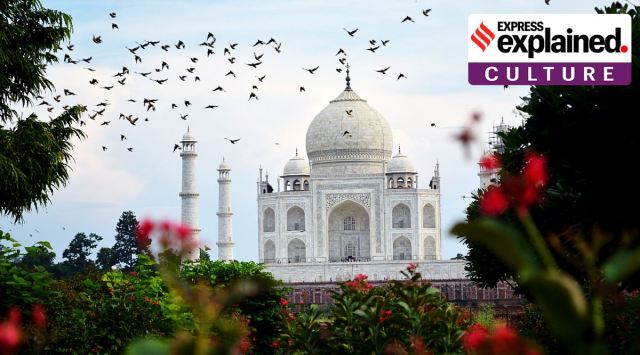Taj Mahal or ‘Tejo Mahalaya’
- Get link
- X
- Other Apps
he Taj Mahal is an ivory-white marble mausoleum on the right bank of the river Yamuna in Agra, Uttar Pradesh, India. It was commissioned in 1631 by the fifth Mughal emperor, Shah Jahan (r. 1628–1658) to house the tomb of his beloved wife, Mumtaz Mahal; it also houses the tomb of Shah Jahan himself. The tomb is the centrepiece of a 17-hectare (42-acre) complex, which includes a mosque and a guest house, and is set in formal gardens bounded on three sides by a crenellated wall.
Construction of the mausoleum was essentially completed in 1643, but work continued on other phases of the project for another 10 years. The first ceremony held at the mausoleum was an observance by Shah Jahan, on 6 February 1643, of the 12th anniversary of the death of Mumtaz Mahal. The mausoleum was opened at that time to thousands of mourners.
The Taj Mahal complex is believed to have been completed in its entirety in 1653 at a cost estimated at the time to be around ₹32 million, which in 2023 would be approximately ₹35 billion (US$498 million).[8] The construction project employed some 20,000 artisans under the guidance of a board of architects led by Ustad Ahmad Lahori, the emperor's court architect. Various types of symbolism have been employed in the Taj to reflect natural beauty and divinity.
The Taj Mahal was designated as a UNESCO World Heritage Site in 1983 for being "the jewel of Islamic art in India and one of the universally admired masterpieces of the world's heritage". It is regarded by many as the best example of Mughal architecture and a symbol of India's rich history. The Taj Mahal attracts around 5 million visitors a year,[3]and in 2007 it was declared a winner of the New 7 Wonders of the World (2000–2007) initiative.
 Considered one of the Wonders of the World and designated a UNESCO World Heritage Site, the Taj Mahal is a global symbol of India and one of the world's most recognised monuments. (ANI Photo/File)
Considered one of the Wonders of the World and designated a UNESCO World Heritage Site, the Taj Mahal is a global symbol of India and one of the world's most recognised monuments. (ANI Photo/File)Allahabad High Court on Thursday (May 12) dismissed a petition filed by BJP leader Rajneesh Singh asking for a fact-finding panel to establish “the real History of Taj Mahal”, and for more than 20 sealed “rooms” to be opened to look for the possible presence of idols of Hindu gods on the premises of the monument.
A day previously, Diya Kumari, the BJP MP from Rajsamand and a member of the erstwhile royal family of Jaipur, had said that the land on which the Taj stands belonged to her ancestors, and “if there is a need for any documents or anything, we will provide the documents if the court orders so”.
Another very important purpose we have in mind in unravelling the Taj Mahal-creation-riddle is to expose the unmethodical and slipshod manner in which many far-reaching concepts have been grafted on Indian history, and foisted on gullible, unsuspecting lay contemporaries and on posterity. Reconstructing the story of the origin of the Taj Mahal should serve as a practice-lesson in research methodology, exposing lapses committed so far and highlighting the principles and safeguards that need to be kept in view by history researchers and teachers. This book is also intended to impress on every reader that it is not the cenotaphs which should monopolize his or her attention. The visitor must go round the entire premises, walk along its long arched corridors, run up the Taj Mahal's many storeys and its marble and redstone towers and minutely examine its many vaulted doorways. The two tombs in the basement and the cenotaphs above them on the ground floor are, if anything, but obstructions in the spacious, octagonal chambers of this ancient Hindu palace. One of these rooms housed the ancient Hindu Peacock Throne which too was grabbed by Shahjahan along with the palace. Thoughtful readers unwittingly but nonetheless irrevocably committed, academically or communally, to the view that Taj Mahal is a Muslim monument are likely to feel perturbed, disturbed and hurt by the revelation in this book. Some others are likely to welcome the discovery of the Taj Mahal's ancient Hindu origin as a coveted truth. To both such we would like to say that to us Truth is like water - tasteless and colourless, divine, pure and life - giving - neither sweet nor bitter. For us Truth is a mere object of discovery - as, in fact, it should be in all creative endeavour. We hardly care if some feel elated or dejected by the discovery of the Hindu antecedents of the Taj Mahal.
- Get link
- X
- Other Apps